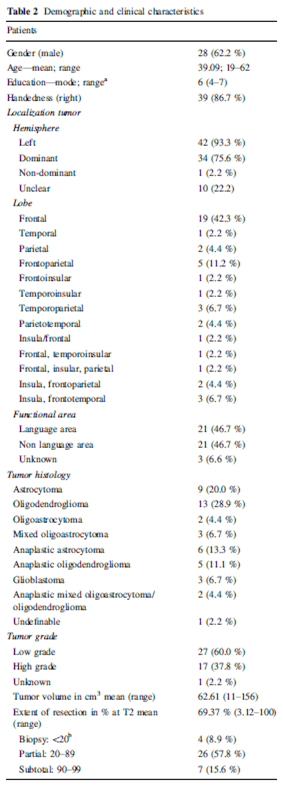
During this period between 20, 498 patients underwent surgery of intracranial gliomas in our department.ĭecision for surgery was made during an interdisciplinary conference including neurosurgeons, neuro-oncologists, neuroradiologists, neuropathologists, and radiation oncologists in all cases. Four patients with glioma of the basal ganglia did not undergo surgical resection but stereotactic biopsy. These departments were European university departments or at least of university level concerning the range and numbers of surgeries. Moreover, clinical outcomes were assessed during follow-up.īetween 20, we resected 47 out of 51 supratentorial gliomas, which were primarily judged to be non-resectable during prior consultation at another neurosurgical department. Neurological course, preoperative nTMS, intraoperative DCS mapping, and IOM data were reviewed and related to new postoperative deficits and postoperative imaging. Thus, we present this retrospective analysis and evaluated all cases that presented to our department for a second opinion. Although the literature and data on eloquent glioma surgery are broad, no studies or subgroup analyses are at hand that analyzed the actual functional outcome and oncological benefit of surgery in patients initially diagnosed as inoperable. By carefully choosing a multimodal setup including preoperative mapping of motor and language function using navigated transcranial magnetic stimulation (nTMS), intraoperative cortical and subcortical mapping using direct cortical stimulation (DCS), intraoperative neuromonitoring (IOM), and awake surgery, we can increase safety and, therefore, allow resection of most such tumors with an acceptable rate of postoperative new deficits. To achieve both goals, neurosurgeons use multiple modalities to examine, visualize, and monitor anatomy and function presurgically and during resection. Resection of such highly eloquent gliomas always involves a compromise between the extent of resection and the preservation of motor or language function. Nonetheless, many gliomas within highly eloquent regions, especially within the insula, rolandic region, and the perisylvian cortex of the dominant hemisphere, still frequently undergo limited debulking or biopsy attributable to the supposed risk of surgery-related deficits. Surgical tumor reduction has been shown to have a impact on survival and quality of life and, thus, has to be as extensive as possible. In specialized centers, most highly eloquent gliomas are eligible for surgical resection with an acceptable rate of surgery-related deficits therefore, they should be referred to specialized centers.įor the treatment of high- and low-grade gliomas, surgery is an important part of a multimodal therapy. Median Karnofsky Performance Scale was 85 before and 80 after surgery). Progression-free follow-up was 11.3 months (range: 2 weeks – 64.5 months) and median survival was 14.8 months (range: 4 weeks – 20.5 months). Postoperatively, 17 of 47 patients (36%) had a new motor or language deficit, which remained permanent in 8.5% (4 patients). Thereby, gross total resection was achieved in 35 cases (74%). IOM was required in 38 cases (81%) and was stable in 18 cases (47%), whereas MEPs changed the surgical strategy in 10 cases (26%).


ResultsĪwake surgery was performed in 8 cases (17%). All data, including pre and intraoperative brain mapping and monitoring (IOM) by motor evoked potentials (MEPs) were reviewed and related to the postoperative outcome. Out of these, 25 were glioblastomas WHO grade IV (53%), 14 were anaplastic astrocytomas WHO grade III (30%), 7 were diffuse astrocytomas WHO grade II (15%), and one was a pilocytic astrocytoma WHO grade I (2%). Methodsīetween 20, we resected 47 out of 51 supratentorial gliomas (92%), which were primarily evaluated to be non-resectable during previous presentation at another neurosurgical department. However, pre and intraoperative brain mapping, intraoperative neuromonitoring (IOM), and awake surgery increase safety, which allows resection of most of these tumors with a considerably low rate of postoperatively new deficits. Nevertheless, many gliomas within highly eloquent cortical regions, e.g., insula, rolandic, and left perisylvian cortex, still do not undergo surgery because of the impending risk of surgery-related deficits at some centers. Today, the treatment of choice for high- and low-grade gliomas requires primarily surgical resection to achieve the best survival and quality of life.


 0 kommentar(er)
0 kommentar(er)
